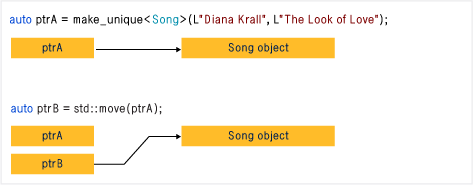unique_ptr 不共享它的指针。 它无法复制到其他 unique_ptr,无法通过值传递到函数,也无法用于需要副本的任何 C++ 标准库算法。 只能移动 unique_ptr。 这意味着,内存资源所有权将转移到另一 unique_ptr,并且原始 unique_ptr 不再拥有此资源。 我们建议你将对象限制为由一个所有者所有,因为多个所有权会使程序逻辑变得复杂。 因此,当需要智能指针用于纯 C++ 对象时,可使用 unique_ptr,而当构造 unique_ptr 时,可使用 make_unique Helper 函数。
下图演示了两个 unique_ptr 实例之间的所有权转换。

unique_ptr 在 C++ 标准库的 <memory> 标头中定义。 它与原始指针一样高效,可在 C++ 标准库容器中使用。 将 unique_ptr 实例添加到 C++ 标准库容器很有效,因为通过 unique_ptr 的移动构造函数,不再需要进行复制操作。
示例 1
以下示例演示如何创建 unique_ptr 实例并在函数之间传递这些实例。
unique_ptr<Song> SongFactory(const std::wstring& artist, const std::wstring& title)
{
// Implicit move operation into the variable that stores the result.
return make_unique<Song>(artist, title);
}
void MakeSongs()
{
// Create a new unique_ptr with a new object.
auto song = make_unique<Song>(L"Mr. Children", L"Namonaki Uta");
// Use the unique_ptr.
vector<wstring> titles = { song->title };
// Move raw pointer from one unique_ptr to another.
unique_ptr<Song> song2 = std::move(song);
// Obtain unique_ptr from function that returns by value.
auto song3 = SongFactory(L"Michael Jackson", L"Beat It");
}
这些示例说明了 unique_ptr 的基本特征:可移动,但不可复制。 “移动”将所有权转移到新 unique_ptr 并重置旧 unique_ptr。
示例 2
以下示例演示如何创建 unique_ptr 实例并在向量中使用这些实例。
void SongVector()
{
vector<unique_ptr<Song>> songs;
// Create a few new unique_ptr<Song> instances
// and add them to vector using implicit move semantics.
songs.push_back(make_unique<Song>(L"B'z", L"Juice"));
songs.push_back(make_unique<Song>(L"Namie Amuro", L"Funky Town"));
songs.push_back(make_unique<Song>(L"Kome Kome Club", L"Kimi ga Iru Dake de"));
songs.push_back(make_unique<Song>(L"Ayumi Hamasaki", L"Poker Face"));
// Pass by const reference when possible to avoid copying.
for (const auto& song : songs)
{
wcout << L"Artist: " << song->artist << L" Title: " << song->title << endl;
}
}
在 range for 循环中,注意 unique_ptr 通过引用来传递。 如果你尝试通过此处的值传递,由于删除了 unique_ptr 复制构造函数,编译器将引发错误。
示例 3
以下示例演示如何初始化类成员 unique_ptr。
class MyClass
{
private:
// MyClass owns the unique_ptr.
unique_ptr<ClassFactory> factory;
public:
// Initialize by using make_unique with ClassFactory default constructor.
MyClass() : factory (make_unique<ClassFactory>())
{
}
void MakeClass()
{
factory->DoSomething();
}
};
示例 4
可使用 make_unique 将 unique_ptr 创建到数组,但无法使用 make_unique 初始化数组元素。
// Create a unique_ptr to an array of 5 integers.
auto p = make_unique<int[]>(5);
// Initialize the array.
for (int i = 0; i < 5; ++i)
{
p[i] = i;
wcout << p[i] << endl;
}
有关更多示例,请参阅 make_unique。